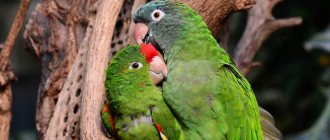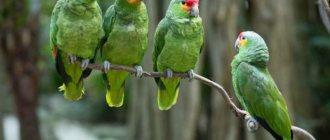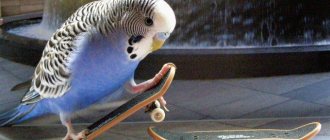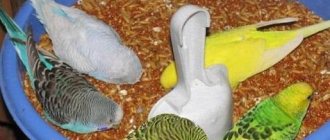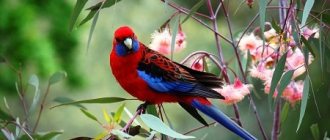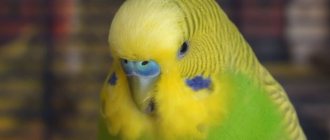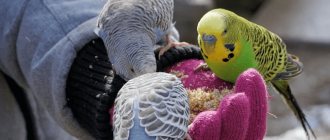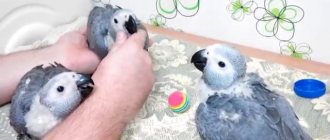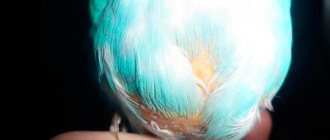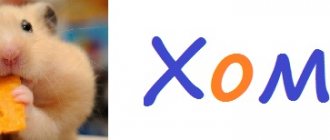Where do parrots live?
These colorful, chirping birds live in tropical and subtropical environments. More than half of all species live in Australia, almost a third are in the countries of South and Central America, and a small part lives in Africa and the countries of South Asia. These birds do not live in natural conditions on the territory of the CIS countries. Parrots usually live in forests, but can also live in steppe or mountain conditions. Abandoned termite mounds, hollows or burrows are chosen as housing. They lead a collective lifestyle.
Parrot - description
A characteristic feature of the parrot is its bright color: blue, red or green, many have long crests and tails. Most species of these birds fly well and climb trees. The parrot's feet have four toes, pointing forward and backward in pairs. Poorly flying species often have a greenish coloration, allowing them to hide in bushes or grass thickets. The movable, powerful and sharp hook-shaped beak of a parrot allows not only to grind the food it has caught, but also serves the bird for defense, and when traveling along the branches of trees it serves as an additional support - the “third paw”.
The weight of parrots ranges from tens of grams to kilograms. Females are usually smaller than males.
How long do parrots live? In natural conditions, the age of some species of parrots reaches 50 years, and when kept in captivity it rarely exceeds 35. Parrots have a creaky, noisy voice, but the ability to onomatopoeia and well-developed memory allow them to copy the voices of other birds, animals and even humans.
external reference
| Wikimedia Commons has media related to Psittacidae . |
| Wikispecies has information related to Psittacidae |
- "Real Parrot" on Encyclopedia of Life
- "Psittacidae". Integrated Taxonomic Information System.
- Parrot video on the Internet Bird Collection
| Taxon identifiers |
|
Types of parrots
Lori parrots or Loriaceae
They feed on pollen and drink nectar; they have a thick brush on the tip of their tongue. Loris parrots are widespread in Indonesia and Australia. They have very beautiful and colorful colors. They nest in tree hollows.
Jaco parrots or gray parrots
Birds are famous for their ability to imitate human speech. Especially the African parrot - gray. He can remember more than a hundred words.
In terms of “ability to talk,” the Amazon parrot is not much inferior to the Gray. In nature, parrots do not imitate human speech, but use only a small set of sharp, piercing sounds that are unpleasant to human hearing.
Budgerigars
Since ancient times, people have bred and kept many types of parrots as ornamental birds. Birds tolerate captivity well. These birds also include budgerigars, which are considered one of the most popular in the world. Budgerigars can also talk, but teaching them requires a lot of effort and time.
Kea parrots
A very interesting type of parrot. The size of the bird is slightly larger than a Jaco parrot (40-50 cm). Kea are found in flocks in the mountains of New Zealand, above the forest belt - where there is snow and strong winds in winter, and constant fog in summer. Harsh conditions do not frighten kea parrots. It has adapted to such conditions and even lays eggs in July (at this time it is winter here).
Kea parrots feed on plant foods, fruits, and flower nectar. Keas are famous for the fact that sheep sometimes become their victims. All kea eat meat, but only individual members of the flock kill.
When hunting a sheep, the bird lands on the ground not far from the intended victim, and then suddenly jumps onto its back and clings to the wool. The sheep with a sharp movement throws the bird off, and the bird sits on its back again and again - until the exhausted animal falls. Sometimes a sheep begins to run with a “rider” until the running leads to its death or the animal frees itself from its pursuer.
Interestingly, before the arrival of Europeans in New Zealand, there were no mammals (with the exception of one species of rats and bats). Therefore, kea until this time did not know the taste of meat.
Macaw parrots
A genus of very large and beautiful parrots, the body length can reach more than 1 meter. They are widespread in South and Central America. Macaws are long-lived and can live more than 70 years.
Cockatoo parrots
These birds are distinguished as a separate family of cockatoos. They belong to the order Parrots. Cockatoos are widespread in Australia. They are quite large in size (up to 70 cm). One of the most common among this family is the white or white-crested cockatoo.
Amazon parrots
Very funny and cute parrots, mostly green in color. They are considered to be long-lived. The sizes are average.
Corella parrots
They belong to the Cockatoo family. In their genus, cockatiels are the only species. Color ranges from gray-olive to light blue.
Parrots Lovebirds
Beautiful, cute and funny parrots are small in size, mostly no more than 18 cm. They usually live in flocks, and when nesting they look for a mate for a long-term relationship.
Lovebirds are widespread in the southwest of the African continent.
Ringed Parrots
A genus of medium-sized birds. The genus includes 15 species. The main habitats are Asia and Africa. A distinctive feature of these parrots is the presence of a long stepped tail. Parrots are usually green in color.
Macaw
A fabulously beautiful bird native to South America. The spectacular multi-colored parrot seems to be painted with bright watercolors of all shades of the rainbow. Birds of this species grow up to a meter in length and live 30–90 years. They learn well and can perform complex tricks, they speak in phrases and according to the situation, their brain is very well developed. The voice is shrill and unpleasant. Keeping such a majestic bird at home is inconvenient and inhumane, so macaws are mainly found in circuses, zoos, and nature reserves.
The difference in plumage color gives grounds to divide these parrots into four groups:
- the genus of macaws, in which there are 13 species;
- blue-fronted fellow;
- hyacinth, the largest and most expensive parrot on the planet;
- blue is a rare species, endangered.
The macaw is friendly towards humans and expects constant communication and care, like a small child. The remarkable abilities and colorful plumage of multi-colored parrots make people commit crimes. Poachers catch bright macaws for profit, aborigines - for food, and also to use feathers as decoration.
Parrot breeding
Before mating, parrots undergo mating games, after which the fertilization process occurs, which is characteristic of all birds. The female parrot lays from 2 to 9 eggs and begins to incubate them. The male can also participate in this process. The period of appearance of chicks depends on the species and lasts from 18 days to 4 weeks.
The chicks emerge blind and without down and feathers. Their weight does not exceed a few grams. Both the female and the male parrot are involved in feeding and raising the offspring. After the chicks learn to fly, they become independent. Parrots reach sexual maturity at the age of 9 months to one and a half years, depending on the species.
Parrot - care and maintenance at home
Parrot selection
When buying a parrot, the first thing you need to pay attention to is age. Young parrots get used to new conditions more easily, are tamed faster, are most often more capable of learning, and are easier to produce offspring from.
Healthy parrots always have elastic, fast movements, plumage that fits tightly to the body, lively, shiny eyes and breathing without wheezing or whistling sounds. It is not recommended to buy parrots that have noticeable violations of these signs. Also avoid buying a parrot with bare areas, this means that the parrot has a tendency to pluck itself.
Transporting a parrot
To transport parrots over a short distance, a special transport cage is required. The size of the transport cage depends on the distance over which the parrot is transported and its size.
If transportation will last more than 3 hours, then a feeder and an automatic drinker must be placed in the cage. When transporting a parrot for more than 2 days, the transport cage should be of a size familiar to the parrot, as if it were living at home.
Parrot cages
Regardless of whether your parrot is kept in an aviary or in a cage, it should be spacious!
Your parrot's cage should not only be spacious, but also easy to maintain and made of non-toxic material. It is best to choose a cage with metal bars, since a bird with its strong beak will most likely chew a cage made of wood, and various parasites may appear in it.
It is best to take a square or rectangular cage. Round cages, of course, look very beautiful, but in such a cage the parrots are more susceptible to stress, since they will not have the opportunity to hide in a corner. In addition, they are very inconvenient to maintain.
The cage should have a high tray where sand can be poured, and besides, the presence of a tray will prevent the food from spilling. The cage should have perches and rings. Perches are best made from hardwood tree branches so that the parrots can chew on them.
The thickness of the perches is of great importance; they should all be different in diameter (from 2 to 12 cm).
In nature, parrots constantly climb branches of different thicknesses, and perches of the same thickness are less comfortable for birds, because their toes are in an almost static position. The cage should be spacious enough for the parrot to freely spread its wings. A padlock must be placed on the cage door. It is better to choose medium-sized feeders and drinkers; the shape does not really matter, the main thing is that it is stable enough. They should also be made of non-toxic materials and not have sharp edges.
Most parrots love to bathe, so it is best to attach a special bath to the cage. Preference should be given to a bath whose bottom is slightly rough; in such a bath the parrot will probably not slip.
Choosing a place for a cage with a parrot
The place where the cage is installed should not be noisy (not located in the aisle, away from speakers and TV). You should not place it close to the window, so that the parrot does not get drafted and does not constantly stand in the sun. It is best to install the cage in a calm, bright place near the wall, so that a suddenly frightened parrot can fly to the wall and feel protected. The cage, depending on its size, can be installed on the floor, hung on the wall, or placed on a special stand. It is advisable for parrots to be in complete darkness at night.
Cleaning a parrot's cage
The cage must be kept clean. The cage and perches need to be cleaned every day or every other day. Feeders and drinking bowls should be washed with hot water every day. The drinking bowl should be wiped clean with a clean towel to avoid the formation of mucus on the walls of the drinking bowl.
Effect of sunlight on parrots
Sunlight is essential for the health of a parrot; if the bird receives the right amount of light, it will grow and develop properly.
In the summer, the parrot's cage must be placed outside for a short time so that its body receives ultraviolet rays. At the same time, there should be shaded areas in the cage so that the bird can hide from the sun. To keep a parrot, it is better if the amount of sun is evenly distributed throughout the year, so in winter, when daylight hours are shorter, artificial lighting is necessary.
The bird should be in the light 14-16 hours a day.
Humidity and air temperature in the room where the parrot is kept
Most parrots do not tolerate changes in temperature and humidity very well, so it is important to maintain stable conditions in the room. For parrots kept in cages, the optimal temperature is considered to be 18-20 degrees. The relative humidity level for parrots should be approximately 60-70%. It is advisable to install a humidifier and air conditioner in the room with the cage.
Stress in parrots
The cause of stress in a parrot can be any sudden change in the external environment, and this can lead to the death of the parrot.
Possible causes of stress:
- sudden change in microclimate;
- prolonged fasting;
- a sharp change in the usual diet;
- cell movement in space;
- insufficient area for movement;
- insufficient number of toys;
- unexpected capture of a parrot;
- sudden bright light or loud noise.
Young parrots are more susceptible to stress; their acquisition itself is often accompanied by stressful situations (street noise, change of environment, new owner). Adult and well-tamed parrots are almost not subject to stress, and this condition occurs very rarely in them.
Remember - all changes in your parrot’s life should occur gradually and then he will be healthy and friendly.
What to feed a parrot at home?
A parrot's diet must be dominated by good quality grain mixtures. The main grains are millet and oats; for larger species, corn, hemp seed and sunflower can be added to the diet. For small parrots - canary seed and a small sunflower. In winter, sprouted grains rich in vitamin E and chopped young lettuce leaves, which can be grown in containers on windowsills, are added to the parrot's food.
Every day, vitamin feed consisting of vegetables and fruits, for example, grated carrots, apples or spinach, mixed with white breadcrumbs, is added to the basic diet. “Street” food collected away from the highway won’t hurt either: clover, dandelions, wood lice. A good treat for parrots is a herbal mixture dried in a dryer or oven. Dry grain mixtures are sometimes replaced with soft foods: millet, rice or oatmeal, low-fat cottage cheese, finely chopped boiled eggs.
The cage should always contain chalk and charcoal, as well as twigs of willow, poplar, rowan or aspen as mineral food. You can add a few drops of lemon juice to the water your parrot drinks.
Happy owners of a loris parrot should pay special attention to the diet of their pet, because in nature birds feed on ripe fruits and nectar of tropical flowers. Therefore, initially the loris is fed with sweet cereals, fruits and honey, gradually accustoming them to grain feed.
Parrots need to be fed in the morning, preferably at the same time. Over time, each owner will learn to calculate the amount of food so that during the day all the food is eaten and the pet is full.
Popular questions
What are the main differences between parrots and other birds?
The parrot cannot be confused with anyone. Look at its massive, down-curved, strong beak. And parrots use it very skillfully. Their beak serves as a device for capturing and grinding food, for climbing trees (just like a third leg), and can also be a formidable weapon. In addition, the parrot has short but developed legs. They help the bird to hold onto the fruits it has caught, and they are also used by the parrot to bring food to its beak.
How many species of parrots are there and where do they live?
There are more than 330 species in the Psittacidae family, and another 20 are part of the cockatoo family, which are also members of the Psittacidae order. All these birds are very thermophilic, which is why they live in subtropical and tropical climates. The most numerous colonies of parrots are in Australia. They are also widespread in the forests of Southeast Asia, West Africa, South and Central America. And a huge number of parrots live in our houses and apartments, because this bird is easily tamed.
What parrots talk?
Parrots differ from other birds not only in the rich colors of their plumage, but also in their ability to “talk.” Of course, parrots do not speak, but only imitate human speech, but this is a very great achievement for a living creature: after all, no one except parrots in the animal world has such an ability. Scientists involved in research into the life and characteristics of parrots claim that the whole point is in the special structure of the speech organs, in particular the language, thanks to which parrots copy human words, perceiving them as the sounds of their “relatives”.
As it turned out, almost all parrots can “speak” and not all of them can accurately reproduce the voice and words of a person. The ability to repeat words after people manifests itself differently in different species of parrots. The best imitators of humans are gray and Amazon parrots, cockatoos and macaws . And gray Jaco parrots copy not only the sounds of human speech, but also the intonation and even the features of the voice. All these birds are usually grouped together under the name " talking parrots ".
What is the most popular pet parrot?
One of the most popular pets in our country is the budgerigar. It got its name from the wavy stripes on its plumage. This small bird loves to make noise and is talkative. Budgerigars remember words and entire expressions quite easily. In the wild, these birds live in Australia, where they roam from place to place in huge flocks in search of food and water.
What is the largest parrot in the world?
In the South American jungle there lives a large parrot with blue-cobalt plumage - it is impossible not to recognize it. This is a hyacinth macaw. The body length of this giant can reach 1 meter, and its weight can reach 1.5 kilograms! The bird has a massive black beak, and at the base of the mandible there is a wide golden stripe. The loud and sharp guttural voice of this parrot can be heard at a distance of more than a kilometer from the bird’s location.
What is the life expectancy of parrots?
Contrary to the common misconception that the lifespan of parrots can reach 100 years or more, this is by no means true: it is rare for their age to exceed 50 years. Although there is information about parrots 65–70 years old.
According to the Green Parrot Bird Hospital, the life expectancy of budgerigars in captivity is 12-13 years, with 1 in 100 budgerigars living to be 16 years old, and 1 in several thousand budgerigars living to be 18-19 years old. Also, in the bird hospital, the life expectancy of Cuban Amazons in captivity was determined precisely - they reach old age at 35 years, and they practically do not overcome the 40-year life threshold.
Which member of the parrot family lives the longest?
This is a gray parrot, or gray parrot.
Its average lifespan is approximately 60 years. However, some individuals live up to 90! The gray's body length is 30 centimeters. It has a black curved beak and gray feathers. Jaco has a high intelligence and excellent ability to imitate.
Recommendations
- Snyder, N; McGowan, P; Gilardi, J; and A. Grajal (2000), Parrots: status review and conservation action plan, 2000-2004.
. Chapter 1. vii. IUCN ISBN 2-8317-0504-5. Chapter 1. vii. - Snyder, N; McGowan, P; Gilardi, J; and A. Grajal (2000), Parrots: status review and conservation action plan, 2000-2004.
. Chapter 1. vii. IUCN ISBN 2-8317-0504-5. Chapter 2. page 12. - ^ a b c
Joseph, Leo;
Cartoon, Alicia; Schirtzinger, Erin E.; Wright, Timothy F.; Schodde, Richard (2012). "Revised nomenclature and classification of taxa of the parrot family group (Psittaciformes)". Zootaxa
.
3205
: 26–40. Doi:10.11646/zotaxa.3205.1.2. - del Hoyo (1997). Handbook of Birds of the World, Volume 4
. Lynx Editions. item 281. - Nicole E. White; Matthew J. Phillips; M. Thomas P. Gilbert; Alonso Alfaro-Nunez; Eske Willerslev; Peter R. Mawson; Peter B.S. Spencer; Michael Bunce (2011). "Evolutionary history of cockatoos (Aves: Psittaciformes: Cacatuidae)" (PDF). Molecular phylogenetics and evolution
.
59
(3):615–622. Doi:10.1016/j.ympev.2011.03.011. PMID 21419232. - Manuel Schweitzer, Ole Seehausen and Stefan T. Hertwig (2011). "Macroevolutionary patterns in parrot diversification: impacts of climate change, geological events, and key innovations." Journal of Biogeography
.
38
(11):2176–2194. Doi:10.1111/j.1365-2699.2011.02555.x. - Lev Joseph; Alicia Toon; Erin E. Schirzinger; Timothy F. Wright (2011). “Molecular systematics of two mysterious genera. Psittacella
and
Pesoporus
illuminate the ecological radiation of Australasian parrots (Aves: Psittaciformes)."
Molecular phylogenetics and evolution
.
59
(3):675–684. Doi:10.1016/j.ympev.2011.03.017. PMID 21453777. - Wright, T.F.; Schirzinger E. E.; Matsumoto T.; Eberhard J. R.; Graves G. R.; Sanchez J. J.; Capelli S.; Muller H.; Scharpegge J.; Chambers G.K.; Fleisher, R. C. (2008). "Multilocus molecular phylogeny of parrots (Psittaciformes): support for a Gondwanan origin in the Cretaceous". Mol Biol Evol
.
25
(10):2141–2156. Doi:10.1093/molbev/msn160. PMC 2727385. PMID 18653733. - Schweizer, M.; Seehausen O; Guntert M; Hertwig S. T. (2009). "The evolutionary diversification of parrots supports a pulse model of the taxon with multiple transoceanic dispersal events and local radiation." Molecular phylogenetics and evolution
.
54
(3):984–94. Doi:10.1016/j.ympev.2009.08.021. PMID 19699808. - de Kloet, R. S.; de Kloet S. R. (2005). "Evolution of the Spindle Gene in Birds: W and Z Spindle Gene Intron Sequence Analysis Reveals Four Major Divisions of the Psittaciformes". Molecular phylogenetics and evolution
.
36
(3):706–721. Doi:10.1016/j.ympev.2005.03.013. PMID 16099384.
Interesting facts about parrots
- Parrots are unsurpassed sound imitators: they imitate human speech, reproduce animal sounds, and even try to repeat pieces of music. Moreover, birds perform all these masterpieces of imitation only with the help of their mouth, tongue and beak, since parrots do not have vocal cords.
- The black cockatoo has the largest beak among parrots: it reaches a length of 10-13 cm. It is not surprising that with such a “tool” the bird can easily bite through thick branches and can even snatch a person’s finger.
- Due to their excellent ability to quickly get used to new living conditions and not suffer from changes in their usual environment, parrots were often tamed by sailors setting off on long voyages. The feathered companions happily traveled on ships and brigantines across countries with their owner, without experiencing any discomfort.
- Unlike many living creatures on the planet, parrots remain faithful to their spouse all their lives.
- Being socially organized, parrot birds create populations of more than 70 thousand individuals.
- Among birds, parrots are considered long-lived - representatives of especially large species can live up to 100 years.
- The weight of a newborn budgerigar is only 2 grams, and an adult woodpecker parrot, living in Papua New Guinea, weighs 11.5 g with a height of 9 cm. But not all parrots are small: the Amazon parrot grows up to 1 meter in height.
- Thanks to monocular vision, a parrot can use each eye independently of the other, with a viewing speed of 150 images per second, compared to only 16 for humans.
- Like humans, a parrot can be right- or left-handed.
- The gray parrot became famous for its knowledge of languages and a rich vocabulary of 400 words, and therefore was included in the Guinness Book of Records.
- Parrot owners living in Australia have the opportunity to send their feathered friend to a school, where even the most silent and uncommunicative pet will be patiently taught spoken language, and then examined and assessed for achievements.
- In Australia, for example, drunken parrots periodically fall from the sky, frightening and perplexing residents. It turns out that birds eat special plants, the juice of which instantly has an intoxicating effect on the birds.
- Parrots are very musical and have a wonderful sense of rhythm. The band Hatebeak, which has released 3 albums, has Waldo the parrot as its vocalist.
- Among these cute feathered creatures there are also dangerous predators: for example, kea parrots hunt sheep.
Video
Color
The standard color of budgerigars in nature is green. There is yellow plumage on the head, blue spots, sometimes purple, on the sides. They are black on the throat, with the help of which sometimes inexperienced owners try to determine age. On the back of the head and body there are waves painted black, which is why the self-explanatory name was obtained.
The age of a bird can be determined by the type of wax (you can also determine the sex) and by where the waves begin (in chicks - from the head):
- The color of the wax is pink-violet in males, blue or light purple in females.
- In adult males, the viscosum is bright blue, in females it is white.
Feet of birds are blue-gray or pinkish, claws are black. There are only four fingers, two look forward, two look back.
Thanks to this, the bird can climb various surfaces without problems.
